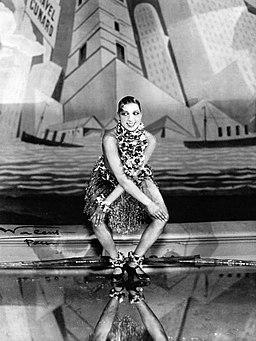1920s Flapper Fashions
I attend a recreational dance class and each year the school puts on an end-of-year show. This year my class has decided to base our dance on a 1920s party theme including a Charleston. We've stared working on the steps so now it's time to start researching the costumes. I thought this would make a great theme for my remix.
Fashion of the 1920s (from Wikispaces.com)
Flapper dresses (from Wikipedia)
"The 1920's, also known as the roaring twenties, was known as a time of change, "out with the old and in with the new!"
Fashion changed dramatically
Previous woman's clothing covered much of their bodies and was very constricted, but in the 1920's women's fashion was turned around
- hemlines rose, making the legs the focus
- since hems were shorter, stockings and shoes became more elaborate
- less fabric was used for dresses
- materials such as rayon were being used to make clothing to give women more mobility, naturally since women were involved in more activities. eg sports, dancing, and driving automobiles
- brighter colors and more textures
- pantsuits became stylish
- beads were incorporated onto dresses hats and bags
- the style was to be thin with no womanly curves, a "teen" look"
So, what is the flapper look?
"Flapper dresses were straight and loose, leaving the arms bare (sometimes no straps at all) and dropping the waistline to the hips. Silk or rayon stockings were held up by garters. Skirts rose to just below the knee by 1927, allowing flashes of leg to be seen when a girl danced or walked through a breeze, although the way they danced made any long loose skirt flap up to show their legs. To enhance the view, some flappers applied rouge to their knees. Popular dress styles included the Robe de style. High heels also came into vogue at the time, reaching 2-3 inches (5-8 cm) high."
Copyright Wikipedia under CC BY-SA.

Josephine Baker was the quintessential, Charleston dancing, flapper girl.
By Walery, French, 1863-1935 (http://estonia.usembassy.gov/) [Public domain], via Wikimedia Commons
I also feel it's important to get the shoes right.
C20th Fashion History By Pauline Weston Thomas for Fashion-Era.com
"Once shoes began to be mass manufactured in the 1920s footwear became an essential fashion accessory. Now it was truly visible beneath shorter dresses it needed to be selected with more care. Heels were over 2 inches high and waisted until the 1930s when they were lower straighter Cuban shapes. Strapped shoes were called Mary Janes. T-bar shoes or others with buckles and bows made interesting fashion statements. Sequin or diamante trims were quite usual."
Copyright Fashion-era.com
So, it's clear that my shoes need to be just as ritzy as my frock. Hopefully, if I'm hep, I won't be a dud. I'll be the cat's meow!
Reflection
For this remix I used 2 works the Creative Commons license BY-SA, one resource in the public domain, and an All Rights Reserved work used here under Fair Dealing as per New Zealand Copyright Act 1994.
I had wanted to use as open a license as possible but it difficult to find resources with attribution only type licenses. Once you have to mix different types of licenses together your choices rapidly become limited (as I discovered in the remix game) and of course, as soon as a work has a ShareAlike license anything you create from that has to have the same. I found several a very nice pictures and pieces of text but had to ditch them because their licenses were not compatible to be used for a derivative work. I had thought the photos might be a bit tricky but actually finding text sources with compatible licenses near impossible. In the end I had to search specifically for Creative Commons ShareAlike text and avoiding anything that mentioned "non-commercial" to find the Wikispaces piece. And thank goodness for the photo of Josephine Baker which is in the public domain because the photographer died over 70 years ago. Attribution wasn't necessary for this photo but I've put it in anyway (It still feels wrong not to).
Amazingly, I've ended up with a Free Culture License! How did I manage that?! Did I manage it? Does use of the extract from the All Rights Reserved work mean that I can't actually license my remix under Creative Commons?
This exercise was really hard and took hours!
This work is licensed under a Creative Commons Attribution-ShareAlike 3.0 Unported License.
#OCL4Edu - Hi Fiona, I posting this comment as a very belated bit of course work. I have to say that I too spent hours on this task. I concluded that CC licenses have to used carefully, as they carry their own complications. I have come to view "All Rights Reserved" licenses as the proverbial "kiss of death" for intellectual freedom. That may be a rather extreme view, but there is certainly a lot de facto restrictions on works that could materially improve (and by extension save and prolong) the lives of many people, particularly in poor and developing nations.
ReplyDelete